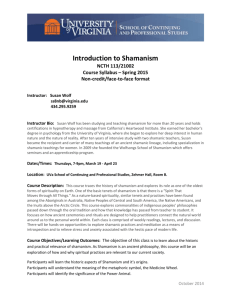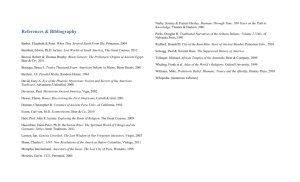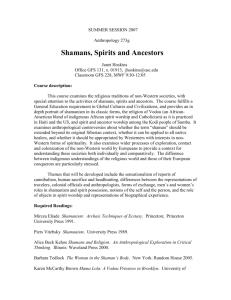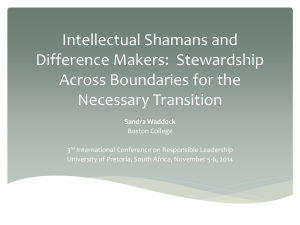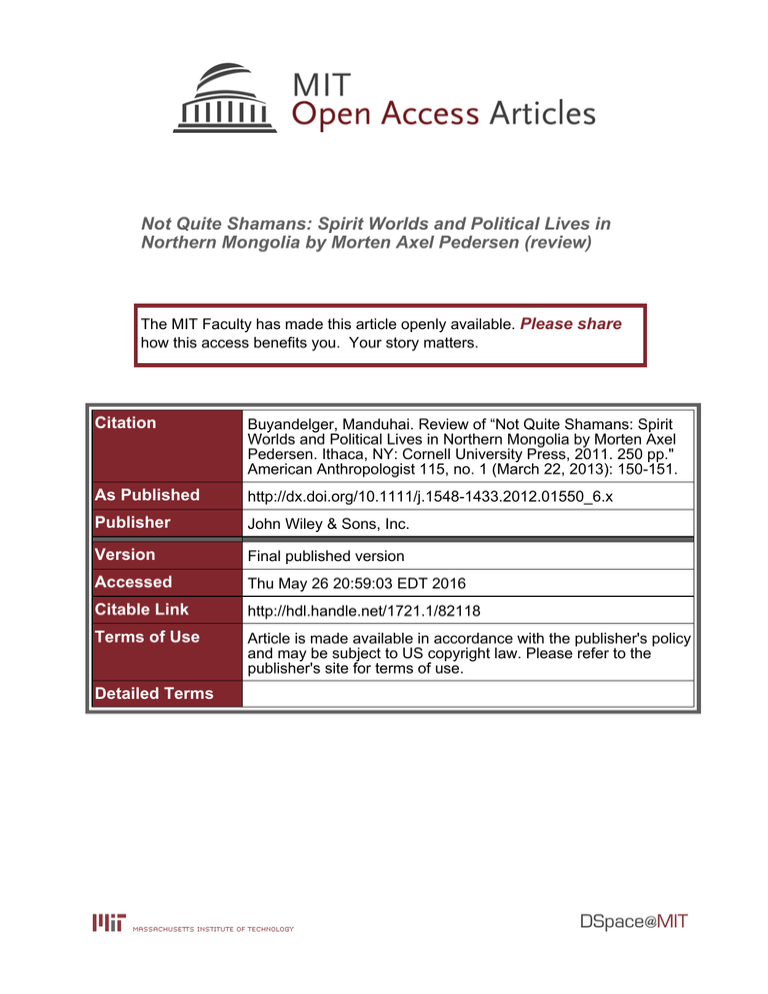
Not Quite Shamans: Spirit Worlds and Political Lives in
Northern Mongolia by Morten Axel Pedersen (review)
The MIT Faculty has made this article openly available. Please share
how this access benefits you. Your story matters.
Citation
Buyandelger, Manduhai. Review of “Not Quite Shamans: Spirit
Worlds and Political Lives in Northern Mongolia by Morten Axel
Pedersen. Ithaca, NY: Cornell University Press, 2011. 250 pp."
American Anthropologist 115, no. 1 (March 22, 2013): 150-151.
As Published
http://dx.doi.org/10.1111/j.1548-1433.2012.01550_6.x
Publisher
John Wiley & Sons, Inc.
Version
Final published version
Accessed
Thu May 26 20:59:03 EDT 2016
Citable Link
http://hdl.handle.net/1721.1/82118
Terms of Use
Article is made available in accordance with the publisher's policy
and may be subject to US copyright law. Please refer to the
publisher's site for terms of use.
Detailed Terms
AMERICAN ANTHROPOLOGIST
BOOK REVIEWS
Book in Translation
The Jaguar and the Priest: An Ethnography of Tzeltal Souls
Pedro Pitarch. Linda Schele Series in Maya and Pre-Columbian Studies. Austin: University of Texas Press,
2011. 284 pp.
Thor Anderson
San Francisco State University
This monograph carefully explores the detailed and intimate
topographies of the inner self in Cancuc, a Tzeltal-speaking
Maya municipality in highland Chiapas, México. It is beautifully written and produced and is clearly a unique and
important contribution to Mesoamerican scholarship and
beyond. A startling finding from this part of the world is that
the soul is not, strictly speaking, a unitary concept. Rather,
there are three distinct realms of spiritual identity; multiple
and possibly conflicting elements reside within everyone—
perhaps in the form of jaguars or priests but in a number of
other guises as well. They are shadowed, obscured, and may
not necessarily be revealed within one’s lifetime. In these
circumstances, self-reflection can be a tricky affair, not to
mention understanding others and their mixed motivations.
This is a rich and complex inner landscape. By comparison, Western notions of the soul seem undeveloped, even
childlike in their simplicity. This is an ethnography of a very
special stamp: without maps or diagrams, it offers close descriptions of places that do not exist by any conventional definition. Further, both the material collected in this volume
and its analysis challenge the received wisdom of contemporary Maya ritual, creating possibilities for new interpretive
perspectives in a field that too often “discovers” what it is
looking for and no more.
One can infer that the ethnographic information in this
text was extracted from deep and sustained dialogues with
a handful of close friends and collaborators. Topics were
clearly revisited over time, and “answers” were not always
forthcoming. Mayanists will be rewarded with some fascinating surprises: for example, the house is not considered a
model of the universe, as faithfully reported elsewhere in the
region, but is presumably just a house. Spectacular public
rituals, subjected to a great deal of scrutiny and analysis in
nearby communities, are likewise said to be almost entirely
devoid of meaning. Local processions and ceremonies are
presented as carefully performed mimetic remnants of bygone colonial rites, and people were quite disinterested in
speculating on the deeper meanings of such matters. Contrariwise, domestic rituals of hearth and home were the
subjects of extensive comment and commentary.
One domestic ritual, a curing ceremony, is recorded in
detail. As the author points out, despite decades of anthropological research in the region, the texts of curing prayers
are understudied and not well understood. This case study
aptly demonstrates the complexities of the soul in maintaining good health, as a ritual specialist diagnoses and treats a
young man’s grave illness. A curer must first distinguish between simple bodily ailments and a range of illnesses caused
by evil-doing entities, generally aspects of other people’s
souls on the loose. The three elements of Tzeltal souls are
(1) “the bird of the heart,” shared by all people of Cancuc; (2)
a miniature, shadowy human form that resides both in the
heart and within one of four ancestral mountains; and (3) as
many as 13 additional entities, including personnel and objects drawn from across space and time. An abbreviated list
includes natural phenomena (such as winds, meteorological
phenomena, and lightening bolts) and a variety of wild animals, as well as priests, teachers, evangelical musicians, and
an extraordinary collection of hybrid creatures—for example, steel-edged tools with the bodies of water snakes. These
reside in the heart and may also roam the earth, at times with
deleterious effects on others. An individual’s personality is
a result of the innate character of their miniature human
entity of the second category and the panoply of entities in
the third category, which skip generations through one’s lineage. Because these elemental aspects of the soul are almost
entirely drawn from the Spanish colonial past, it is suggested
that souls are in fact alien to personhood—indeed, the soul
is the symbol and the seat of the “other” within. Following
this reasoning, the Tzeltal soul encapsulates history itself.
The historical and ethnohistorical information that links
imagery and infuses meaning into Tzeltal soul life is finely
interwoven throughout the text, in a sense replicating a local
c 2013 by the American Anthropological
AMERICAN ANTHROPOLOGIST, Vol. 115, No. 1, pp. 145–152, ISSN 0002-7294, online ISSN 1548-1433. Association. All rights reserved. DOI: 10.1111/j.1548-1433.2012.01550.x
146
American Anthropologist • Vol. 115, No. 1 • March 2013
view of time past—pervasive yet quite imprecise in any
strictly linear sense. Local archives reflect the shared power
of the written word: for the anthropologist, their content
is inserted in a broader narrative, while in the community
setting, caches of documents, mostly from the 19th century,
exert symbolic power by their mere existence. Even as this
monograph takes pains with historical memory, the original
Spanish version was based on research carried out some 20
years ago, and it is unfortunate that this translation–revision
did not include a postscript to make some account for the past
two decades of deep social change in the region. Of course,
discovering whether and how this place and its distinctive
views of self, causation, and society survive the vicissitudes
of time and modernity is a task for future research. But even
in the short term, this work has gently toppled the apple cart
of conventional anthropological wisdom in the highlands. In
a land of intensive studies and restudies, the findings of The
Jaguar and the Priest are instructive, salutary, and profound.
Single Reviews
Living the Drama: Community, Conflict, and Culture among
Inner-City Boys
David J. Harding. Chicago: University of Chicago Press, 2010. 315 pp.
Victor Rios
University of California, Santa Barbara
Generations of studies have habitually rendered “urban
youth” and “violence” synonymous. This academic preoccupation with marginalized young men, in particular, and
violence has created an often-vexed industry of ideas that
claim to explain why young people commit violence.
David Harding enters this field attempting to understand
how violence affects the everyday lives of young men. He
asks, “What is it about poor neighborhoods that matters for
the individual adolescents who grow up in them?” He finds
that neighborhood context matters, that “violence structures
adolescent boys’ safety and their use of space in the city”
(p. 25). From his findings, he develops a few concepts that
become useful for understanding processes and outcomes
relating to poor boys. These include cultural heterogeneity,
cross-cohort socialization, and leveling expectations, among
others. Although Harding does enter a saturated field that
addresses violence among inner-city boys, his contribution is
unique and is bound to change the way in which scholars analyze violence and other social phenomenon amid marginalized young men.
Harding’s most important idea is that of cultural heterogeneity. He critiques social isolation theory—the notion that individuals living in concentrated poverty will develop unique subcultures that are compensatory and often
oppositional to mainstream culture. He finds that “poor
neighborhoods are actually sites of intense cultural conflict
rather than dominant deviant subcultures” (p. x). He argues
that young people living in poverty have access to conventional cultural models, such as acquiring college educations
or becoming responsible fathers, and indeed have aspirations and a limited amount of resources to live up to these
models.
Harding explains that although cultural heterogeneity
exists in all social environments, the content of the messages
within each cultural frame a youngster encounters and the
kinds of social support each frame has available in a particular
neighborhood context are actually what makes it different
in poor settings. So if, for example, a youngster in a poor
neighborhood aspires to go to college and his single mother
constantly pushes him to do so, his peers on the streets and
older siblings may support an alternative frame (i.e., success
in this context means not getting arrested and not becoming
victimized by violence). Harding explains that standards of
achievement are low in poor neighborhoods because of older
peers who have encountered negative fates such as dropping
out, prison, or victimization. This process he calls “leveling
expectations.” Young people reduce their expectations based
on competing notions of success in a context where violence
is a central preoccupation.
Harding argues that cultural heterogeneity has negative
consequences because
it is hard to process multiple competing and conflicting cultural
models, particularly for adolescents, who struggle to find their
own identities . . . the social environment provides a weaker signal
about what option is best, because there is social support for many
different options. Since there is less consensus or agreement where
there is greater heterogeneity, it will be harder for the adolescent
to choose between competing options. The result may be weaker
commitment to the chosen option and a lower likelihood of follow
through. [p. 156]
This process, what Harding refers to as “model shifting,”
can have devastating consequences for youngsters because
the structural conditions they live in combined with the
social support they find for specific cultural models often
determine an amplification of cultural models that leads to
health-compromising behaviors.
Some questions that this reader is left with have to do
with agency: Does cultural heterogeneity always necessarily
Book Reviews
result in negative outcomes? What about resilience and
young people’s ability to reason through the variety of options at hand? What alternative outcomes exist in the context
of cultural heterogeneity? Future studies might grapple with
how multiple frames might also prove beneficial under certain conditions.
The implications of Harding’s findings are major. If
we are able to provide more social support and not
necessarily new cultures of achievement—which already
exist in poor settings but are weakened by structural
conditions—then we can help young people diminish other
dominant cultural frames that lead to detrimental conse-
147
quences. Our job is to introduce resources that will provide youngsters with the ability to expand certain positive cultural frames; it is not to try to change the internal workings of young people or to teach a hard
work ethic because these notions are already embedded
in the social fabric of everyday life among poor inner-city
youths.
Living the Drama is an exceptional book that will help
frame discussions about inner-city boys for years to come.
It promises to be useful in discussions among undergraduate
and graduate students in classes on urban studies, crime, and
youth development.
Gender, Sexuality, and Meaning: Linguistic Practice
and Politics
Sally McConnell-Ginet. Oxford University Press, 2011. 312 pp.
Liza Bakewell
Brown University
Some scholars, on retirement, slow down. Others pick
up speed. Fortunately, Sally McConnell-Ginet, Professor
Emerita, Department of Linguistics at Cornell University, is
of the latter, which is why we now have a valuable collection
of some of her most poignant articles on gender and language, freshly edited, introduced, and concluded. (It is also
why we may be blessed someday with a cookbook dedicated
to eggplant.)
Divided into three sections that are buttressed by a prelude and a coda, Gender, Sexuality, and Meaning, as languageand-gender scholar Mary Bucholtz points out in the forward
to the compendium, is an introduction to the author’s work
on language and gender as much as it is a historical artifact that documents the history of the study of language and
gender over the past 30 years. There are other important
contributions that this collection of articles makes as well.
One is the book’s demonstration of the hard work a dedicated feminist and interdisciplinarian has done over the years
to bring to the fore the underlying work of language—in cahoots with its speakers, of course—to perpetuate the status
quo of heterosexual male privilege. The second is a call for
change and even on occasion a prescription to do so.
The first section, “Politics and Scholarship,” which collects three chapters under its title, evolved from lectures and
papers that addressed the intersections of sociolinguistics,
anthropology, and feminism with formal linguistics, particularly semantics, and makes a case for the value of bringing disciplines together in pursuit of understanding the full
meaning—and action—of words. Some things have changed
since those articles were first written but not a whole lot.
The field of linguistics is only slightly more open to genderfocused studies, and sociolinguists continue to dominate the
subfields of linguistics that do consider gender. McConnellGinet’s Ph.D. is in formal linguistics. However, when she
began teaching, she immediately realized the value of looking at the gender – language interface to deepen her understanding of meaning, which led to decades of productive
collaborations with colleagues in sociology, anthropology,
literature, and the literary arts. Eventually, as president of
the Linguistic Society of America, she was in a strong position
to make a difference. So she did.
Section 2, “Social Practice, Social Meanings, and Selves,”
includes articles cowritten with McConnell-Ginet’s longtime friend and collaborator Penny Eckert, who was William
Labov’s first graduate student; together they put into interdisciplinary practice what is laid out in section 1. Here there
is much discussion of the term communities of practice, coined
by two other linguists, to circumscribe the gendered doings
of language. “A CofP is any group that interacts regularly
around some concern, interest, or activity,” they write,
“the members of which hold one another ‘accountable’ in
various ways for their participation in some common social practice(s)” (pp. 90–91, emphasis added). They then
go on to unveil the larger social and political settings, including ideologies, to which these CofP are tied. (In 2003,
McConnell-Ginet and Eckhart also coauthored a landmark
book, Language and Gender, published by Cambridge).
The third section, “Constructing Content in Discourse,”
publishes data and analyses by a feminist semanticist influenced by other fields of inquiry. Here you’ll find a call to
arms. “Meanings are produced and reproduced within the
political structures that condition discourse: though a sexist politics may have helped some men to ‘steal the power
148
American Anthropologist • Vol. 115, No. 1 • March 2013
of naming,’” the author writes in her chapter, “The Sexual
(Re)production of Meaning,” “that power—a real one—can
be re-appropriated by feminist women and men building
new language communities” (pp. 181–182). In “‘Queering’
Semantics,” the author demonstrates how this has been done
with the word queer, and in “Prototypes, Pronouns, and
Persons,” she discusses the singular use to which the words
they or them are being put. (They or them, if you haven’t
noticed already, have evolved into the singular and are well
on their way to replacing he and she when a generic reference
is desired.) On the they–them issue, McConnell-Ginet uses
the singular term themself in her opening chapter as a kind
of synthesis.
For anthropologists, the value of this collection lies not
only in the research findings, new or old (but by no means
dated), which will be of interest to scholars as well as students, but also in having, between two covers, an assembly
of scholarly articles that do help to summarize, paradigmatically if not comprehensively, the small—and wildly
groundbreaking—field of language and gender.
REFERENCE CITED
Eckert, Penelope, and Sally McConnell-Ginet
2003 Language and Gender. Cambridge: Cambridge University
Press.
Making War in Côte d’Ivoire
Mike McGovern. Chicago: University of Chicago Press, 2011. 236 pp.
Ralph Austen
University of Chicago
In this engaging, well-informed, and consistently insightful book, Mike McGovern analyzes developments in Côte
d’Ivoire (CI) between 2002 and 2007. Despite his title,
McGovern’s topic is not war (none occurred in CI during
this period) but, rather, various elements of violence, militarization, and international intervention that amounted to
“war-making as a process rather than an event” (p. xviii).
He eschews any general argument beyond insistence “on a
multicausal explanation” but then, in a distinction between
anthropology and more economistic or rational-choice approaches, “insists on the importance of bringing all these
incentives, motivations and justifications into line with one
another” (pp. 24–25).
One of McGovern’s most useful insights is to show how
“warring” Ivorian conflicts, usually defined primarily along
ethnic-regional lines, are also based on history (precolonial
slave trading as well as colonial force and classificatory discourse), intergenerational tensions, and opportunistic criminality extending across national and continental boundaries.
He does a nice job of describing the differing cultures of
CI’s rich coastal forest regions (decentralized, thinly populated, open to Christian conversion) and the poorer northern savannahs (mainly Mande, Muslim, and closely linked
to immigrants from surrounding Burkina Faso, Mali, and
Guinée). He avoids essentializing these identities, in part
because he recognizes that the actual politics of the country
have tended to operate on what he (perhaps over-) theorizes
as “thirdness”—that is, how other elements consistently mitigate such binaries. Thus, tension between the two southern
regions has been at least as salient as their supposed common “Ivoirité” in opposition to the Muslim northerners or
immigrants. The current government was, in fact, formed
through an electoral alliance between leaders of the southeast and north against the incumbent southwestern-based
regime of Laurent Gbagbo.
It is less “thirdness” than a combination of political economy and Freudian-cum-Lacanian psychology that informs
McGovern’s account of intergenerational conflict, particularly in the southwest, where a once-flourishing cocoa economy was built on the labor of—but also by selling land
rights to—migrants from both the north exterior and the
west. In contrast to other analysts who have seen this crisis largely in local economic terms, McGovern stresses the
disappointment of younger men who had been sent to the
capital for education but, in the declining national economy
of the 1980s onward, found no white-collar employment
there and returned home to discover that their agricultural
patrimony was not as lucrative as before and, more critically,
in the possession of “foreigners.” Psychology, for McGovern, is necessary to understand the intense and violent nature
of the response to this situation, although other observers
might find the socioeconomic conditions (incl. university
student politics)—which McGovern actually examines more
closely—to be sufficient. McGovern also gives considerable
attention to the popular culture (particularly music) of this
new generation with its often-radical negation of the existing social order but implies that it is still contained within
a framework of “play” and “supplication” (a hope for some
rewards as the result of protest).
The great father figure of all postcolonial CI is of course
its late first president, Félix Houphouët-Boigny, who is both
blamed by McGovern for establishing an ultimately untenable regime of export-based patronage in close collaboration with France and praised for producing a legitimate
national identity, based on his concern that the material
benefits of his power be widely shared. Houphouët was a
Baule from the southwest and a man much interested in
Book Reviews
Muslim–Christian dialogue as well as economic investment
in the north, so it is not surprising that the current ruling
party calls itself RHDP (Rassemblement des Houphouétistes
pour la Démocratie et la Paix). Meanwhile, it is in the now
politically isolated southeast that McGovern sees a continuing breakdown of order, justice, and the conservation of
natural resources (linked to parallel developments in neighboring Liberia).
Given the events that occurred between late 2010
and early 2011, which are only partially recounted in
McGovern’s “Afterword” (an electoral victory by the RHDP,
Gbagbo’s resistance and arrest after an invasion of the
149
capital by dissident military forces from the north with
support from UN and French troops), it is perhaps just
as well that this book does not provide a more decisive
synthesis of the factors promoting and constraining violence in contemporary CI. Readers will still learn a great
deal about the breakdown and continuing coherence of a
state once seen as a shining “miracle” of economic prosperity and political order and will at least be convinced
that only inquiries into history and culture in its various
inherited and modern forms can, as McGovern argues,
“yield meaningful insights into political decision-making”
(p. xix).
Icons of Life: A Cultural History of Human Embryos
Lynn M. Morgan. Berkeley: University of California Press, 2009. 310 pp.
Janelle S. Taylor
University of Washington
Icons of Life is a powerfully argued, theoretically and methodologically innovative, and impressively researched study
of how early-20th-century embryo collectors and embryologists, through their work, created new scientific understandings of human embryological development that
became the basis for more broadly shared cultural understandings of the origins of individual human life.
Icons of Life opens with the story of author Lynn Morgan’s encounter with an old collection of bottled embryos
discovered in a basement at the women’s college where
she teaches. Her own response to this collection, shaped
by her immersion in contemporary U.S. cultural politics of
abortion, was one of revulsion and incomprehension, mixed
with “a complicated sadness . . . for the scientific practice
that reduced so many women’s reproductive experiences
to a forgotten assemblage of zoological specimens pickled
in formaldehyde” (p. 2). Who collected these embryos and
fetuses? From whom? Why? And how did they end up so
abandoned?
It is in the spirit of an anthropologist seeking to understand the foreignness of the past, as well as how it ushered in
our familiar present, that Morgan has pursued her questions
about embryology into archives, laboratories, museums, and
collections, as well as through interviews. The result is a truly
remarkable book that makes visible the vast (and now quite
thoroughly forgotten) social, cultural, scientific, and material work that went into creating contemporary imaginings
of pregnancy and the unborn.
In Icons of Life, Morgan argues that embryo collecting
formed a critical stage in the establishment of what she calls
“the embryological view of development” (p. 10), which so
thoroughly undergirds contemporary understandings that
it is surprisingly difficult even to recognize it as a view
rather than a series of self-evident facts about the world. As
Morgan describes it, “the embryological view of development” is premised on four key assumptions: (1) that each
human life begins at conception, passes from embryo to baby
to human, and this is the only route to becoming a full human
being; (2) that all human pregnancies produce human embryos; (3) that embryos are amoral biological entities; and
(4) that embryological knowledge is true. As obviously true
as they might today seem, none of these four points would
have been straightforwardly acceptable in the world out of
which the embryo collectors themselves emerged. Indeed,
their work of collecting, storing, preserving, dissecting, and
studying embryos, circulating them among networks of scientific colleagues, and mobilizing many others to do the
same—these could hardly have been carried out by people
who accepted today’s understandings of what embryos are
and what they mean. That same work, however, also ushered
in “the embryological view of development,” thus setting
the stage for its own erasure from view. By illuminating this
process, Icons of Life succeeds in accomplishing—for human
reproduction and in a historical vein—the quintessentially
anthropological project of “making the familiar strange, and
the strange familiar.”
Methodologically, Icons of Life offers an innovative exemplar of how history may be approached with an anthropological sensibility. The book presents telling, and quite
heartbreaking, details concerning the lives and circumstances
some of the (unnamed) women from whom early embryologists obtained the embryos that became their work objects. The book also speaks more broadly to a number of
theoretical debates central to contemporary sociocultural
anthropology, thus positioning this study of the history of
human embryos squarely at the center of discussions of topics such as the social construction of scientific knowledge,
the ethics of research on materials of human origin, the
historical intertwining of ideologies of race with those of
150
American Anthropologist • Vol. 115, No. 1 • March 2013
gender; the cultural workings of visual representations, and
the broad question of how discourses get made. In this regard, Icons of Life demonstrates powerfully the potential of
feminist research on gender and health to illuminate areas
of scholarly inquiry that might, on first consideration, seem
quite unrelated to these topics.
No less important, however, this is one of those rare
scholarly works that also stands to make a significant contribution to public discussion of the topic it addresses. It is suitable for teaching in advanced undergraduate- or graduatelevel courses and will be read with interest and profit not
only by anthropologists but also by historians, feminists, and
other educated readers seeking fresh insight into contemporary issues. Icons of Life is a model of clear and engaging
scholarly writing that is deeply informed by the most serious high-level discussions in contemporary social theory
but that at the same time remains very accessible. Morgan’s
voice as an author is even toned and restrained, yet her
lively sense of humor, as well as her slow-burning anger at
the injustices that her research reveals, remain discernible
beneath her understated text. This book addresses professional anthropologists on topics that concern them and in
a way that they will recognize as subtle and interesting,
but it does so without turning its back on readers who
are not immersed in our scholarly community and its jargon. Icons of Life is a remarkable work that seems destined
to have a significant impact both within and well beyond
anthropology.
Not Quite Shamans: Spirit Worlds and Political Lives in
Northern Mongolia
Morten Axel Pedersen. Ithaca, NY: Cornell University Press, 2011. 250 pp.
Manduhai Buyandelger
Massachusetts Institute of Technology
Not Quite Shamans is a welcome contribution to the literature
on the occult and supernatural, shamanism, postsocialism,
and Mongolia. Morten Axel Pedersen conducted his fieldwork in northern Mongolia—in Shishged Depression among
Darhads, who are famous, at least in Mongolia, for having the
most “authentic” shamans. When Pedersen arrived to conduct his research in late 1990s and early 2000s, however,
he found a paradox: the homeland of shamanism, where
shamans persevered even through the harshest persecution
during socialism, was now barren. Instead of shamans, the
place was full of böö shig or böörhuu individuals (shaman-like
or sort-of-a-shaman-but-not-quite). These are almost exclusively young men who ought to be shamans but are unable
to become them because of lack of teachers (i.e., “authentic”
and accessible shamans in the area) and insufficient resources,
among other things, to obtain shamanic paraphernalia that
are necessary for appeasing and controlling the spirits—the
traits of trained shamans. And, thus, they suffer attacks by
spirits. These men’s propensity to drinking and staging agsan
(a violent outbursts of anger, uncontrolled body movements
like kicking the stove, and bursts of inappropriate language)
and other disruptive behaviors are seen as the outcome of
their exposure to spirits—the multiple external agencies—
which make them “dividuals” rather than individuals, and for
that they are mad, troublesome, and misfortunate. Without
teachers and shamanic costumes, these men are stuck in a
perpetual state of being incomplete shamans. Some of them
are also atamans—the informal big men who reside over
local gangs and maintain their power over the community
through terror. By all means, these are the Other to the rest.
Pedersen illustrates how the daily lives of Darhads are
affected by these not-quite-shamans. His main argument is
that the lack of shamans does not make the Darhad life
any less shamanic. Quite the contrary, without shamans,
shamanism (loosely defined as the constellation of various
occult practices, imaginaries, and discourses) thrives and
seeps through every pore of the moral, cultural, and natural
lives in Shishged. Indeed, Pedersen’s next set of arguments is
about the propensity of the postsocialist transformation to be
shamanic and about how postsocialist political events create
conditions that incline people to take a shamanic perspective. For instance, following a local teachers’ strike in late
1990s and other related political events, the Shishged community seemed to go have gone through a collective right of
passage. Those events loosened up the stable and predictable
structure of socialism by having people to become a part of
the instability, multiplicity, and unexpected transformations
(i.e., good wives going on a drinking spree), which opened
the possibility for everyone to become a potential shaman.
Life without shamans, as author states, is just as shamanic—
or even more so—as a place with real shamans, the nearest
“center” of which is located more than 100 kilometers to the
north.
To illustrate these and other points, different chapters
of the book examine examples of unconventional shamanic
realms. Pedersen calls them “difficult forms,” as they are in
constant flux, ambivalent, and multiple. For instance, the
state with its signs of failed socialist modernity and current political instability is shamanic. Even the locals’ way of
decorating their houses with the portraits and posters of electoral candidates resemble a vertical succession of shamanic
Book Reviews
spiritual pantheon or skys (tengri). That is, unlike the socialist
state that was seen as a single and stable entity, the postsocialist one is multiple, fluid, and divisive, which resembles
the not-quite-shamans who are governed by their shifting
agencies of agsan and sobriety. Even during non-agsan, they
cannot be trusted because they do not fit in the expected
norms of age, gender, and social hierarchy. Their notorious jokes, sarcasm, “lies,” and their bodily dispositions—
hödölgööntei (moving a lot), öt shig (wormlike), and golguy
(without center)—make most people uneasy and doubtful
about their personhood. There is a clear analogy between
the not-quite-shamans and the Mongolian postsocialist state.
Ridden with internal conflict, constantly changing its composition through elections, and unable to build a coalition
(center) to do its job, the postsocialist state has been in a
permanent state of incompleteness and incompetency.
Many anthropologists of modernity, postcolonialism,
and postsocialism will find exciting and useful conversations
and ideas in this book. For instance, Pedersen shows that the
Darhads already have their Other, the not-quite-shamans,
and do not necessarily need an outsider to construct that category. In that sense, shamanism-without-shamans is not just
a metaphor for transformation but, rather, is a condition on
its own right and “an indigenous theory of societal transition,
and the most recent actualization of transition as a virtual
ontological state” (p. 223). For scholars of shamanism, Pedersen, by demonstrating that it is not always the shamans
who carry the practice to the new generations but the en-
151
tire community, reveals some nuances behind shamanic resiliency around the world, despite all sorts of suppressions by
states, Buddhism, Christianity, and other powers. The less
that shamanism is bound to individual shamans, the farther
it spreads out and more fiercely it pushes the boundaries of
what Pedersen (p. 211) refers to the “fixity of meanings”
in Michael Taussig’s (1987:412) phrasing. (Pedersen’s idea
compliments my own work on Buryat Mongolians, in which
I illustrate the role of remembering and forgetting and gender [Buyandelger in press] in shamanic proliferation after
socialist disruption and argue that it is the community that
makes and unmakes the shamans [Buyandelgeriyn 1999].)
Finally, the book successfully takes shamanism away from
the notion of exotic and traditional but shows its modernities
and many ways in which shamanism “spills over [its] forms,”
quintessential and even modern and incomplete.
REFERENCES CITED
Buyandelger, Manduhai
In press Tragic Spirits: Shamanism, Memory, and Gender in Contemporary Mongolia. University of Chicago Press.
Buyandelgeriyn, Manduhai
1999 Who “Makes” the Shaman? The Politics of Shamanic Practices
among the Buriats in Mongolia. Inner Asia 1:221–244.
Taussig, Michael
1987 Shamanism, Colonialism, and the Wild Man: A Study in
Terror and Healing. Chicago: University of Chicago Press.
Political Ecologies of Cattle Ranching in Northern Mexico:
Private Revolutions
Eric Perramond. Society, Environment, and Place series. Tucson: University of Arizona Press, 2010. 259 pp.
Casey Walsh
University of California, Santa Barbara
Anthropology and related disciplines share a long-standing
focus on pastoralism: its protagonists, histories, economics,
ecologies, social organization, and culture. A range of contemporary problems—deforestation, erosion, aquifer depletion, and loss of biodiversity and food sovereignty, to
name a few—have been attributed to the ceaseless expansion of cattle and meat and dairy production. Eric Perramond’s Political Ecologies of Cattle Ranching in Northern Mexico
provides a well-rounded field study of many of the key issues
associated with this livelihood in the semiarid highlands of
the Sonora River.
Perramond treads an ambitious, winding, and holistic
trail in this book and is largely successful in driving home an
array of arguments. The introduction to the book presents
a trio of concerns that are dealt with throughout the entire
text: (1) the evolution of ranching and the constitution of
ranchers as a social category, (2) work and management,
and (3) ecology and natural resources. In all of these areas,
the author insists on depicting the complexity, diversity, and
specificity of ranching in highland Sonora with a keen ethnographic eye focused during more than a year of fieldwork.
The ethnography is the basis for a number of critiques of the
literature on land tenure, social class, range management,
and ecology, all of which point out the tendency of scholars
toward oversimplification and reductionism.
Property—particularly the distinction between private
and public ownership of ranch lands—is perhaps the central guiding thread in the book. Perramond shows how
the literature on land tenure, ranching, and management
152
American Anthropologist • Vol. 115, No. 1 • March 2013
is premised on a firm, yet erroneous, distinction between
private lands and public lands. In Mexico, these land-tenure
categories form part of a centuries-long struggle to control
the resource, and they are cast in opposition. “Public” and
“private,” then, are massively overdetermined concepts that
have been operationalized in countless different social and
ecological settings in which individual ranchers often control both kinds of lands. Perramond is particularly eager to
dispel the stereotypes that have been used in the struggle
to nationalize and appropriate lands. Apart from the very
biggest ranchers, he tells us, there are no fat cats in the
ranching business, and most ranchers in this book appear as
harried rural small businessmen. The fact that almost everyone in northern Sonora still aspires to be a rancher, even
when it is such a precarious livelihood, allows Perramond to
make a sustained argument for the importance of culture in
economic and ecological research.
The book contains an introduction, a conclusion, and
five substantive chapters. In chapter 2, Perramond provides
historical depth to questions of land tenure and ranching in
Sonora and a comparative sensibility that will appeal to scholars interested in pastoralism. Chapter 3 is a discussion of production, work, infrastructure, and the management of land
cover, water, and soils. Chapter 4 shows an impressive command of the scientific aspects of range landscape and ecology but also concludes that relations of power are a crucial
and often-overlooked aspect of these dynamics. Chapter 5
provides a welcome and very interesting discussion of the
role of gender and women in the reproduction of ranch
households and society and also touches on the transnational
dimensions of household economies. Chapter 6 discusses the
ongoing dynamic between private and communal property
in a ranching economy faced with drought, debt, neoliberal
reforms, free trade, conservation, industrialization, and suburban growth. In the conclusion, Perramond reiterates the
importance of complexity and diversity in the economies and
ecologies of ranching in the Mexican borderlands. He also
provides a list of policy suggestions: an interesting and responsible move that distills his findings and reflects the deep
local knowledge of ranchers in the region, as well as their
desire for concrete recommendations from the academic sector. Here and elsewhere in the book, we see Perramond’s
commitment to the people and land of northern Sonora.
The book corrals an impressively holistic combination of
historical, quantitative, and qualitative field research. Perramond accompanies the variety of data with an equally diverse
set of theoretical tools and authors. Latin names of plants
jostle for space with terms such as tactics, strategy, discourse,
agricultural hegemony, secret geographies, long-wave fluctuations;
long quotes in the local vernacular are juxtaposed with charts
depicting the results of surveys of household labor allocation. With such varied data and so many kinds of arguments
in play, however, this reader longed for a bit of the narrative stability of the overarching theoretical frameworks
that are so ably critiqued in the book. In many ways, the
author’s approach mirrors the political culture of northern
Mexico’s private ranchers discussed in the book: the distrust
of expert knowledge, a sort of authorial individualism, a
wariness of collective (political-intellectual) projects. This
makes for a rich and insightful text, but at times it seems that
Perramond is herding conceptual cats that could be corralled
more effectively in the article format. Regardless of this very
minor quibble, the book is a fine introduction to ranching in
Sonora, and to northern Mexico in general. It would make a
truly valuable text for any course on the Mexico–U.S. borderlands or on ranching, land, and labor in Latin America.


